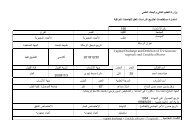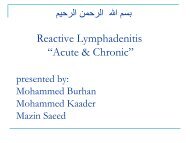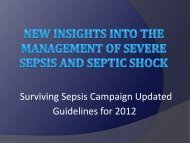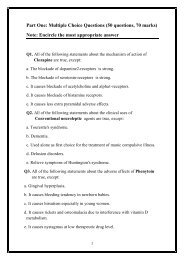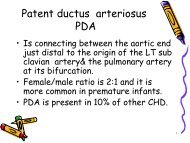Occipitoposterior positions
Occipitoposterior positions
Occipitoposterior positions
- No tags were found...
You also want an ePaper? Increase the reach of your titles
YUMPU automatically turns print PDFs into web optimized ePapers that Google loves.
Fetal MalpositionPresented By:مصطفى صالح موسىليث امجد سعيدSupervised By:د.سعاد الخشاب
Fetal malposition• This refers to the relationship betweenthe denominator & the pelvis that makespontaneous delivery unfavourable , e.g:‣ occipito-posterior in vertex presentation‣ sacro-posterior in breech presentation &‣ mento-posterior with face presentation.
<strong>Occipitoposterior</strong> <strong>positions</strong>• <strong>Occipitoposterior</strong> <strong>positions</strong> are the mostcommon type of malposition of the occiput.• A persistent occipitoposterior position resultsfrom a failure of internal rotation prior tobirth. The vertex is presenting, but theocciput lies in the posterior rather than theanterior part of the pelvis.• As a consequence, the fetal head is deflexedand larger diameters of the fetal skullpresent.
Etiology• The direct cause is often unknown, but it may be due to:1. associated with an abnormally shaped pelvis.2. A flat sacrum or a head that is poorly flexed may beresponsible3. epidural analgesia )relax the pelvic floor to an extentthat the fetal occiput sinks into it rather than beingpushed to rotate in an anterior direction)4. poor uterine contractions may not push the headdown into the pelvis strongly enough to producecorrect rotation
DiagnosisAntenatal diagnosis1 - Listen to the mother• The mother may complain of backache andshe may feel that her baby’s bottom is veryhigh up against her ribs. She may reportfeeling movements across both sides of herabdomen.
2 - Abdominal examination:On inspection:• There is a saucer-shaped depression at orjust below the umbilicus. This depression iscreated by the ‘dip’ between the head andthe lower limbs of the fetus. The outlinecreated by the high, unengaged head canlook like a full bladder
On palpation:• The breech is easily palpated at the fundus,the back is difficult to palpate as it is wellout to the maternal side, sometimes almostadjacent to the maternal spine.• Limbs can be felt on both sides of themidline.
On auscultation:• The fetal back is not well flexed so the chestis thrust forward, therefore the fetal heartcan be heard in the midline.• However, the heart may be heard moreeasily at the flank on the same side as theback.
Diagnosis during labour:• The woman may complain of continuousand severe backache worsening withcontractions.• However, the absence of backache does notnecessarily indicate an anteriorly positionedfetus.• The large and irregularly shaped presentingcircumference does not fit well onto thecervix.
• Therefore the membranes tend to rupturespontaneously at an early stage of labourand the contractions may be incoordinate.Descent of the head can be slow even withgood contractions.• The woman may have a strong desire topush early in labour because the occiput ispressing on the rectum.
Vaginal examination• The findings will depend upon the degree offlexion of the head; locating the anteriorfontanelle in the anterior part of the pelvis isdiagnostic but this may be difficult if caputsuccedaneum is present.• The direction of the sagittal suture andlocation of the posterior fontanelle will helpto confirm the diagnosis {The posteriorfontanelle (three radiating sutures) ispalpable posteriorly}
Management of labour:o The best management is to await events,preparing the woman and staff for a longlabour.o Progress should be monitored by abdominaland vaginal assessment, and the mother’scondition should be watched closely.o Good pain relief with an epidural andadequate hydration are required.
Second stage:In most cases provided that uterine contractionsare strong & the patient is able to make goodexpulsive efforts, the occiput rotate forward &normal delivery take place. In other cases thebaby may be delivered face to pubis with greatrisk of perineal tear.The indications of interference are:1-failure of presenting part to descend.2-fetal distress.3-maternal distress.
CAPACITES DE LEVAGEFLECHE DEPORTEEAvant90°Les valeurs sont exprimées en tonnesPORTEE3,0 m 4,5 m 6,0 m 7,5 m A portée maxiBalancier 2,30 m, contrepoids 4,85 t, attache rapide 285 kgm7,5 m6,0 m4,5 m3,0 m1,5 m0,0 m-1,5 m-3,0 m* Hydraulically limitedLame arrière levéeLame arrière baissée2 stab. baissésLame et stab. baissésLame arrière levéeLame arrière baissée2 stab. baissésLame et stab. baissésLame arrière levéeLame arrière baissée2 stab. baissésLame et stab. baissésLame arrière levéeLame arrière baissée2 stab. baissésLame et stab. baissésLame arrière levéeLame arrière baissée2 stab. baissésLame et stab. baissésLame arrière levéeLame arrière baissée2 stab. baissésLame et stab. baissésLame arrière levéeLame arrière baissée2 stab. baissésLame et stab. baissésLame arrière levéeLame arrière baissée2 stab. baissésLame et stab. baissés2,8* 2,8* 2,0* 2,0*2,8* 2,8* 2,0* 2,0*2,8* 2,8* 2,0* 2,0*2,8* 2,8* 2,0* 2,0*2,6* 2,3* 1,7* 1,7*2,6* 2,6* 1,7* 1,7*2,6* 2,6* 1,7* 1,7*2,6* 2,6* 1,7* 1,7*4,9* 3,8 3,7 2,3 1,6* 1,64,9* 4,4 4,3* 2,6 1,6* 1,6*4,9* 4,9* 43,* 3,4 1,6* 1,6*4,9* 4,9* 4,3* 4,3* 1,6* 1,6*9,9* 6,3 5,7 3,4 3,5 2,1 1,9* 1,3 1,7* 1,39,9* 7,5 6,2* 4,0 4,9* 2,5 1,9* 1,6 1,7* 1,69,9* 9,9* 6,2* 5,1 4,9* 3,2 1,9* 1,9* 1,7* 1,7*9,9* 9,9* 6,2* 6,2* 4,9* 4,3 1,9* 1,9* 1,7* 1,7*4,8* 4,8* 5,1 2,9 3,3 1,9 2,3 1,3 1,8* 1,24,8* 4,8* 7,5* 3,5 5,4* 2,2 2,7* 1,5 1,8* 1,54,8* 4,8* 7,5* 4,6 5,4* 3,0 2,7* 2,0 1,8* 1,8*4,8* 4,8* 7,5* 6,5 5,4* 4,1 2,7* 2,7* 1,8* 1,8*6,1* 4,7 4,8 2,6 3,1 1,7 2,2* 1,26,1* 5,8 8,2* 3,2 5,7 2,1 2,2* 1,56,1* 6,1* 8,2* 4,3 5,3 2,8 2,2* 2,06,1* 6,1* 8,2* 6,1 5,8* 3,9 2,2* 2,2*9,3* 4,8 4,7 2,6 3,0 1,7 2,5 1,49,3* 5,8 7,9* 3,1 5,6 2,0 2,8* 1,79,3* 8,2 7,9* 4,2 5,3 2,7 2,8* 2,39,3* 9,3* 7,9* 6,0 5,6* 3,9 2,8* 2,8*9,7 5,0 4,8 2,6 3,3 1,89,9* 6,0 6,7* 3,2 4,5* 2,29,9* 8,4 6,7* 4,2 4,5* 2,99,9* 9,9* 6,7* 6,1 4,5* 4,24,84,84,84,86,36,36,36,37,17,17,17,17,57,57,57,57,67,67,67,67,47,47,47,46,86,86,86,85,85,85,85,817
1 - Manual rotationWith epidural or general anesthesia or pudendalblock the head is rotated with the hand in thevagina til it directed anterior,the shoulder girdleis rotatedat the same time by pressure throughabdominal wall with the external hand &delivery is completed with obstetric forceps.
2 - Kielland forcepsThis forceps used for rotation of the fetalhead until the occiput lies anteriorly &then for traction.
3 - Vaccum extractiono If the extractor is applied near the occipital endof the vertex & traction is applied, forwardrotation of the head often occurs.o When there is doubt about vaginal delivery atrial of forceps in the operating theatre isperformed, this may occur in:• The baby seems large• Two fifth of head is abdominally palpable• Marked caput or moulding• prominent ischial spines
• If any difficulty is encountered, caesareansection is performed.
Occipito-transverse position• The baby is facing the hip.• The head engages in the left or right occipitotransverseposition, but then rotation tooccipito-anterior will occur• If this fails to occur the head remains in thetransverse position in the second stagecausing deep transverse arrest.
• the occiput transverse position is mostlikely a transitory one because the occiputtends toward the anterior position.
• Unless hypotonic uterine contractions result,either spontaneously or as the consequence ofregional analgesia, spontaneous anteriorrotation usually is completed rapidly, thusallowing the choice of spontaneous deliveryor delivery with outlet forceps.
Delivery• If rotation ceases because of poor expulsiveforces and pelvic contractures are absent, vaginaldelivery usually can be accomplished readily ina number of ways:• The occiput may be manually rotated anteriorlyor posteriorly and forceps delivery performedfrom either the anterior or posterior position.
• Alternatively, clinicians may apply Kiellandforceps to the fetal head in the occiputtransverse position, rotate the occiput to theanterior position, and then deliver the headeither with the same forceps or withSimpson or Tucker–McLane forceps.• If failure of spontaneous rotation is causedby hypotonic uterine contractions withoutcephalopelvic disproportion, oxytocin maybe infused and closely monitored.
• With the android pelvis, the head may not evenbe engaged, yet the scalp may be visiblethrough the vaginal introitus as the consequenceof considerable molding and caput formation.• Consequently, if forceps delivery is attempted,undue force should be avoided.




